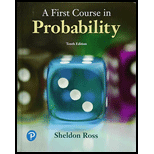
EBK FIRST COURSE IN PROBABILITY, A
10th Edition
ISBN: 9780134753676
Author: Ross
Publisher: PEARSON CUSTOM PUB.(CONSIGNMENT)
expand_more
expand_more
format_list_bulleted
Concept explainers
Textbook Question
Chapter 10, Problem 10.5P
Use the inverse transformation method to present an approach for generating a random variable from the Weibull distribution
Expert Solution & Answer
Want to see the full answer?
Check out a sample textbook solution
Students have asked these similar questions
Can you tell the answer
Theorem 2.4 (The Hölder inequality)
Let p+q=1. If E|X|P < ∞ and E|Y| < ∞, then
.
EXY SEXY ≤ Xp Yq.
2
P(x,y).
kx²y
X: 1,2
5.11273
Find
k
Find P(x/y)
③ Mxy Ng q oxy
ว
Chapter 10 Solutions
EBK FIRST COURSE IN PROBABILITY, A
Ch. 10 - The following algorithm will generate a random...Ch. 10 - Prob. 10.2PCh. 10 - Give a technique for simulating a random variable...Ch. 10 - Present a method for simulating a random variable...Ch. 10 - Use the inverse transformation method to present...Ch. 10 - Give a method for simulating a random variable...Ch. 10 - Let F be the distribution functionF(x)=xn0x1 a....Ch. 10 - Prob. 10.8PCh. 10 - Suppose we have a method for simulating random...Ch. 10 - Prob. 10.10P
Ch. 10 - Use the rejection method with g(x)=1,0x1, to...Ch. 10 - Prob. 10.12PCh. 10 - Prob. 10.13PCh. 10 - Prob. 10.14PCh. 10 - Prob. 10.15PCh. 10 - Let X be a random variable on (0, 1) whose density...Ch. 10 - Prob. 10.1STPECh. 10 - Prob. 10.2STPECh. 10 - Prob. 10.3STPECh. 10 - If X is a normal random variable with mean and...Ch. 10 - Prob. 10.5STPE
Knowledge Booster
Learn more about
Need a deep-dive on the concept behind this application? Look no further. Learn more about this topic, probability and related others by exploring similar questions and additional content below.Similar questions
- The joint density function of two continuous random variables X and Y is: p(x, y) = {Kcos(x + y) Find (i) the constant K 0 0arrow_forwardp(x,y) = {e-x -(x+y) 0 x ≥ 0, y ≥ 0 otherwise find x,y,Exy, by Охarrow_forwardIf X is a continuous random variable having pdf as shown. Find a) the constant k b) P(X>1) c) X, X², 0%, standard deviation. n(x) k -2 -1 0 1 2arrow_forwardThe joint probability function for the random variables X and Y is y 0 1 2 P(X, Y) = x0 [3/28 9/28 3/281 = 13/14 3/14 2 1/28 0 0 0 Find Mx, My, E(XY), OXY.arrow_forwardP(x, y) = {e-(x+y) x≥0, y ≥0 0 otherwise find x, y, x,y JX, 4 буarrow_forwardThe joint density function of two continuous random variables X and Y is: p(x, y) = {Kcos(x- Find (i) the constant K + y) 0 0arrow_forwardA random variable X has a Gaussian distribution. The mean value of X is 2 and the variance is 4 volts. Compute the following probabilities: a) P(X3) c) P(X<-2) d) P(2arrow_forwardLet X and Y be random variables having joint density function 0≤x≤1,0≤ y ≤ 1 find X, Y, 0, 0, OXY otherwise p(x,y) = {x+yarrow_forwardFind the probability in tossing a fair coin three times, there will appear a) 3 H b)2 H 1T c) 2 T and 1 H d) 3 T.arrow_forwardLet the random variable X represents the number of automobiles that are used for different business purpose on any given workday. Xi p(xi) 1 0.3 Find: a) μx b)X2 c) o 2 2 3 0.4 0.3arrow_forwardsurvey of 5050 young professionals found that they spent an average of $20.5620.56 when dining out, with a standard deviation of $11.4111.41. Can you conclude statistically that the population mean is greater than $2323? Use a 95% confidence interval. Question content area bottom Part 1 The 95% confidence interval is left bracket nothing comma nothing right bracketenter your response here, enter your response here. As $2323 is ▼ of the confidence interval, we ▼ can cannot conclude that the population mean is greater than $2323. (Use ascending order. Round to four decimal places as needed.)arrow_forwardQ5: 06: the foot lies between 3 and 4. (20 Marks) Let f(x) = 3*, use Lagrange interpolation to find a second-degree polynomial that agrees with this function at the points x₁ = 0, x₁ = 1, x2 = 2.arrow_forwardarrow_back_iosSEE MORE QUESTIONSarrow_forward_iosRecommended textbooks for you
 Big Ideas Math A Bridge To Success Algebra 1: Stu...AlgebraISBN:9781680331141Author:HOUGHTON MIFFLIN HARCOURTPublisher:Houghton Mifflin Harcourt
Big Ideas Math A Bridge To Success Algebra 1: Stu...AlgebraISBN:9781680331141Author:HOUGHTON MIFFLIN HARCOURTPublisher:Houghton Mifflin Harcourt Glencoe Algebra 1, Student Edition, 9780079039897...AlgebraISBN:9780079039897Author:CarterPublisher:McGraw HillAlgebra & Trigonometry with Analytic GeometryAlgebraISBN:9781133382119Author:SwokowskiPublisher:Cengage
Glencoe Algebra 1, Student Edition, 9780079039897...AlgebraISBN:9780079039897Author:CarterPublisher:McGraw HillAlgebra & Trigonometry with Analytic GeometryAlgebraISBN:9781133382119Author:SwokowskiPublisher:Cengage Functions and Change: A Modeling Approach to Coll...AlgebraISBN:9781337111348Author:Bruce Crauder, Benny Evans, Alan NoellPublisher:Cengage Learning
Functions and Change: A Modeling Approach to Coll...AlgebraISBN:9781337111348Author:Bruce Crauder, Benny Evans, Alan NoellPublisher:Cengage Learning
 Big Ideas Math A Bridge To Success Algebra 1: Stu...AlgebraISBN:9781680331141Author:HOUGHTON MIFFLIN HARCOURTPublisher:Houghton Mifflin Harcourt
Big Ideas Math A Bridge To Success Algebra 1: Stu...AlgebraISBN:9781680331141Author:HOUGHTON MIFFLIN HARCOURTPublisher:Houghton Mifflin Harcourt Glencoe Algebra 1, Student Edition, 9780079039897...AlgebraISBN:9780079039897Author:CarterPublisher:McGraw HillAlgebra & Trigonometry with Analytic GeometryAlgebraISBN:9781133382119Author:SwokowskiPublisher:Cengage
Glencoe Algebra 1, Student Edition, 9780079039897...AlgebraISBN:9780079039897Author:CarterPublisher:McGraw HillAlgebra & Trigonometry with Analytic GeometryAlgebraISBN:9781133382119Author:SwokowskiPublisher:Cengage Functions and Change: A Modeling Approach to Coll...AlgebraISBN:9781337111348Author:Bruce Crauder, Benny Evans, Alan NoellPublisher:Cengage LearningMod-01 Lec-01 Discrete probability distributions (Part 1); Author: nptelhrd;https://www.youtube.com/watch?v=6x1pL9Yov1k;License: Standard YouTube License, CC-BYDiscrete Probability Distributions; Author: Learn Something;https://www.youtube.com/watch?v=m9U4UelWLFs;License: Standard YouTube License, CC-BYProbability Distribution Functions (PMF, PDF, CDF); Author: zedstatistics;https://www.youtube.com/watch?v=YXLVjCKVP7U;License: Standard YouTube License, CC-BYDiscrete Distributions: Binomial, Poisson and Hypergeometric | Statistics for Data Science; Author: Dr. Bharatendra Rai;https://www.youtube.com/watch?v=lHhyy4JMigg;License: Standard Youtube License
Functions and Change: A Modeling Approach to Coll...AlgebraISBN:9781337111348Author:Bruce Crauder, Benny Evans, Alan NoellPublisher:Cengage LearningMod-01 Lec-01 Discrete probability distributions (Part 1); Author: nptelhrd;https://www.youtube.com/watch?v=6x1pL9Yov1k;License: Standard YouTube License, CC-BYDiscrete Probability Distributions; Author: Learn Something;https://www.youtube.com/watch?v=m9U4UelWLFs;License: Standard YouTube License, CC-BYProbability Distribution Functions (PMF, PDF, CDF); Author: zedstatistics;https://www.youtube.com/watch?v=YXLVjCKVP7U;License: Standard YouTube License, CC-BYDiscrete Distributions: Binomial, Poisson and Hypergeometric | Statistics for Data Science; Author: Dr. Bharatendra Rai;https://www.youtube.com/watch?v=lHhyy4JMigg;License: Standard Youtube License
